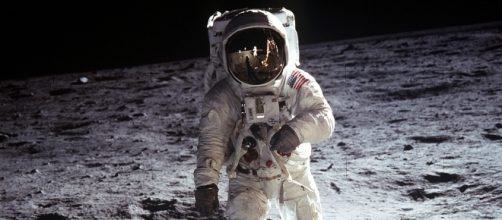Lunar dust and some tiny moon rocks collected by Neil Armstrong are going to be auctioned off by Sotheby’s New York, to mark the 48th anniversary of the first lunar landing on July 20, 1969.
The moon dust scooped up by Armstrong, the first man to set foot on the moon, is expected to fetch an estimated £1.5 million to £3 million.
Other items on the block include a photograph of fellow Apollo 11 astronaut Buzz Aldrin standing on the moon and a documented flight plan that the NASA astronauts used to return to Earth.
Armstrong & Aldrin have just raised US flag. Buzz salutes Old Glory while Neil takes a photo. #Apollo11 pic.twitter.com/NNzkfNCmDu
— Apollo 11 (@ReliveApollo11) July 21, 2015
The mystery of the moon dust
According to Astronotes, Armagh Planetarium’s official blog, one thing that surprised the astronauts who visited the moon was the strong smell of the lunar dust which they were able to smell only when they got back inside the Lunar Module.
After coming into contact with oxygen for the first time inside the Lunar Module, the four billion years old moon dust produced a pungent smell. Neil Armstrong described the scent as similar to wet ashes in a fireplace. Other astronauts compared the odour to that of gun powder. To this day, the distinct smell remains a mystery as the lunar dust and gun powder has no similar compounds.
Mission Apollo 11: A giant leap for mankind
#OTD in 1969, Apollo 11 Astronauts @TheRealBuzz, Neil Armstrong & Michael Collins launched into space, pushing humanity to new frontiers pic.twitter.com/w21C01z5Xu
— NASA Moon (@NASAmoon) July 16, 2017
On July 16, 1969, Apollo 11 took off from Kennedy Space Center with the commander of the mission Neil Armstrong and fellow astronauts Buzz Aldrin and Michael Collins aboard.
Three days later, the mission entered a lunar orbit. On July 20, Armstrong and Aldrin climbed into Eagle, the Apollo lunar module, to reach the lunar surface while Collins remained in the command module.
A few hours later, Apollo 11 touched down on the lunar surface and Armstrong immediately radioed to Mission Control in Houston, Texas: “The Eagle has landed,” a now famous phrase. These were the first words spoken on the moon.
According to NASA, Armstrong had to improvise and pilot the craft manually past an area littered with boulders. “He piloted the craft even farther from the landing site, and descended to the surface of the moon four miles (6.4 km approx.) from the original landing site with less than a minute of descent fuel remaining,” states a CNET report.
“That’s one small step for man, one giant leap for mankind,” Armstrong remarked as he took his first step on the moon. Aldrin joined him shortly, and described the moon’s surface as "magnificent desolation." The duo explored the surface for two and a half hours, collecting samples of lunar dust and rocks and taking photographs, noted NASA.
Along with the American national flag, the Apollo 11 mission left behind a small collection of items that included medallions honouring Russian cosmonauts Yuri Gagarin, the first human to journey into outer space, and Vladimir Komarov, both of whom had tragic deaths; Gagarin in 1968 when the MiG-15 training jet he was piloting crashed, and Komarov due to parachute failure when his Soyuz capsule crashed after re-entry in April 1967.
This made him the first human to die in a space flight.
The mission began its journey home on July 22 and safely splashed down 1,480 kilometres south-west of Hawaii on July 24.
According to Guinness World Records, an estimated 600 million people watched the Apollo 11 landing live on television. A world record that was later broken by Prince Charles and Lady Diana Spencer’s wedding in July 1981 which was viewed by 750 million people worldwide.


